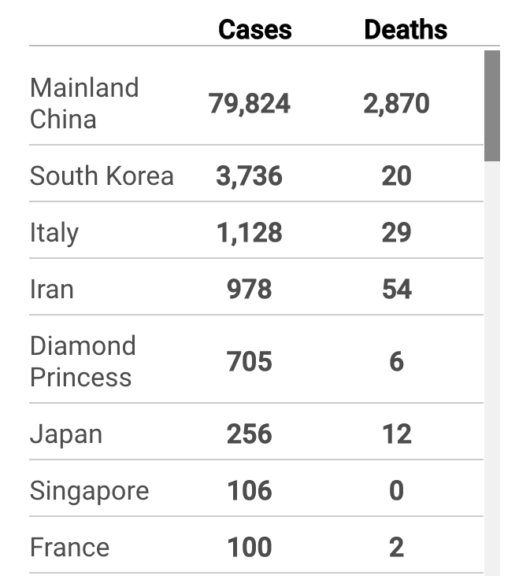I.
In the 1800s, the average US man weighed about 155 lbs. Today, he weighs about 195. The change is even starker at the extremes. Someone at the 90th percentile of weight back then weighed about 185 lbs; today, he would weigh 320 lbs. Back then, about 1% of men were obese. Today, about 25% are.
This puts a lot of modern dietary advice into perspective. For example, lots of people think low-carb is the solution to everything. But people in the 1800s ate almost 50% more bread than we do today, and still had almost no obesity. Other people think paleo is the solution to everything, but Americans in the 1800s ate a diet heavy in bread, milk, potatoes, and vegetables, and relatively low in red meat and other more caveman-recognizable foods. Intermittent fasting – again, cool idea, but your great-grandfather wasn’t doing that, and he had a 1% obesity risk.
This isn’t to say those diets can’t work. Just that if they work, they’re hacks. They treat the symptoms, not the underlying problem. Something went terribly wrong in US nutrition between 1900 and today, and all this talk about low-carb and intermittent fasting and so on are skew to that thing. Given that 1800s Americans seem to have effortlessly maintained near-zero obesity rates while eating foods a lot like the ones we eat today, maybe we should stop trying to figure out what cavemen were doing, and start trying to figure out what Great-Grandpa was doing, which sounds a lot easier.
We get similarly confusing evidence from other countries. Until recently, Chinese people ate mostly white rice. This is exactly the sort of high-glycemic-index carb that low-carbers say should be terrible for you. But the Chinese stayed thin even when they ate a lot. It was only when they started eating processed Western-style food that their obesity rate started to rise.
Or what about France? The French diet is about what you would expect; baguettes, pastries, cheese, meat. Lots of sugar, white flour, and fat – the opposite of all reasonable dietary advice. But 1970s France had the same kind of low obesity rates as 1800s America or China. This is related to the nutritional conundrum famously called the French paradox – why aren’t the French fatter and sicker than they are?
The answer to all these questions seems to be something like “the body is pretty good at regulating its own weight under any diet except modern American processed food.” But what aspect of processed food makes it bad?
A new section of the online nutrition-sphere claims the answer has to do with the way mitochondria process fat. I’ve been trying to read these people and get a feel for their opinions. Most of what I’ve absorbed has come from Brad Marshall of Fire In A Bottle and his posts on The Croissant Diet. I’ve been told that another blog called Hyperlipid has a deeper investigation, but I’ve only scratched the surface of them. The r/SaturatedFat subreddit has some good stuff too. I don’t claim to fully understand these people and I apologize for any misrepresentations I might be making. But the short version is: they all agree that everything went wrong when we switched from saturated to unsaturated fat.
Wait, isn’t unsaturated fat the good kind of fat? Well, yes, this is what everyone else thinks. This is definitely one of those “good things are bad and bad things are good” diets. But let’s take a look at the argument.
In the 1950s, heart disease rates were rising in the US. Realistically, this was mostly because lots of people had started smoking a few decades before, and now all that tobacco was catching up with them. But people didn’t know that at the time, so they did some studies into nutrition, and the studies suggested maybe saturated fat caused heart attacks. So the government told people to replace saturated fat with unsaturated fat, and this was back when the government was competent, so saturated fat consumption plummeted and unsaturated fat consumption shot up.
This paragraph is an extreme oversimplification: saturated fat is mostly found in things like milk, butter, and meat. Unsaturated fat comes in two types: monounsaturated and polyunsaturated. Monounsaturated fat is found in olive oil. Polyunsaturated fat comes in two types: omega-3 and omega-6. Omega-3 is mostly found in fish (“fish oil”). Omega-6 is mostly found in vegetables (“vegetable oil”). If you’ve ever looked at your food and seen ingredients like soybean oil, safflower oil, canola oil, corn oil, et cetera oil, these are omega-6 polyunsaturated fats.
When the government recommended a switch from saturated fats to unsaturated fats around the 1950s, it was omega-6 polyunsaturated fats – vegetable oils – that picked up the slack. Here are some helpful charts:
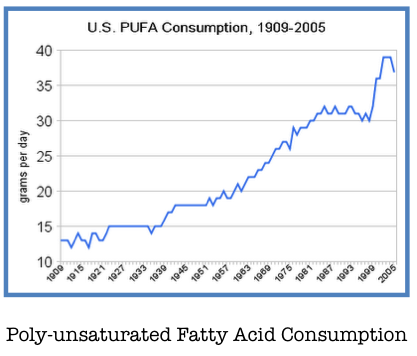
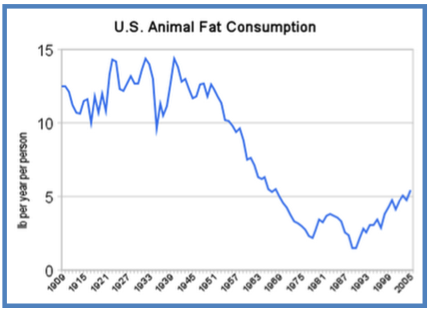
I cannot for the life of me find original sources for either of these graphs, but they seem consistent with everything else I’ve heard so I am going to trust them. Sorry!
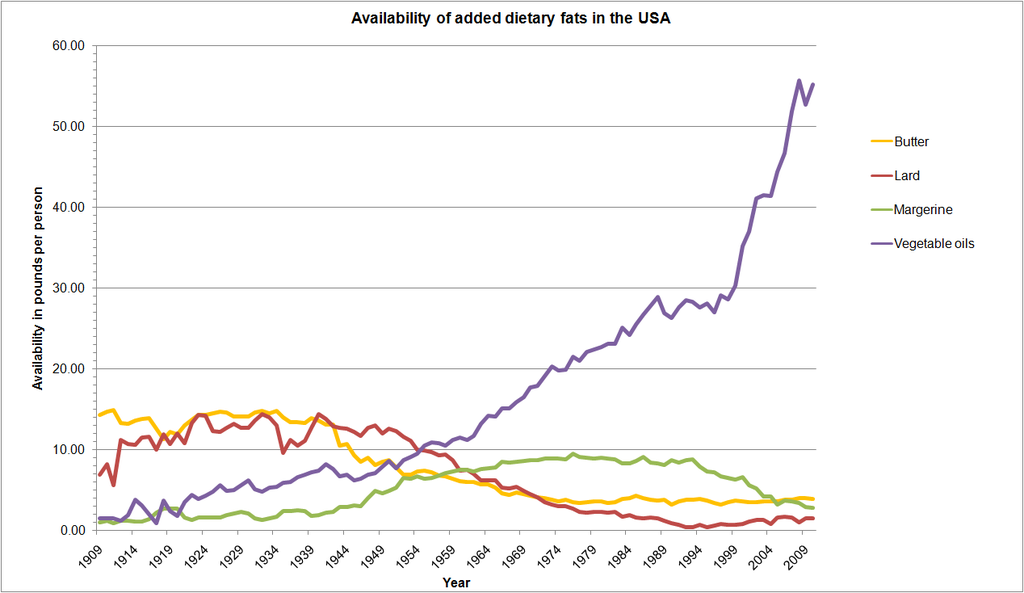
[source]
This dramatic change in consumption of fat was reflected in a dramatic change in the composition of the human body. Studies of human fat cells and breast milk found that they went from being overwhelmingly saturated fat (like the fat cells and breast milk of animals) to being partly polyunsaturated fat:
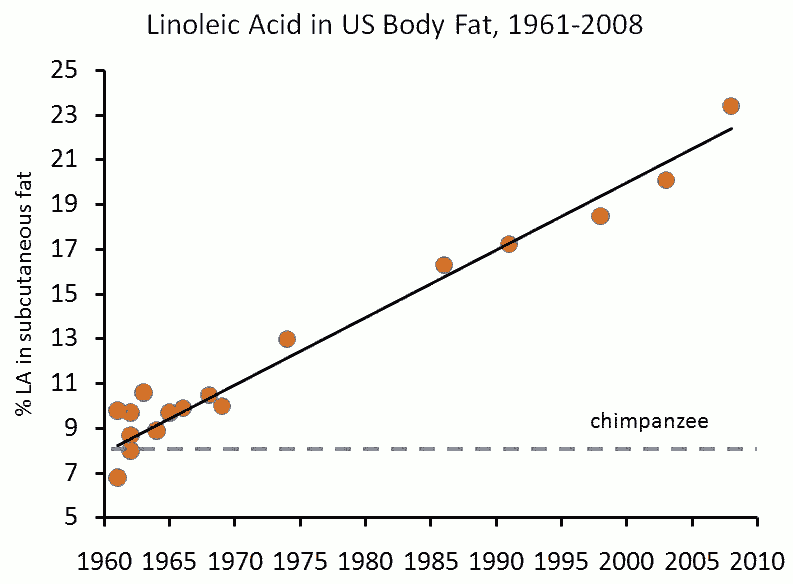
[source, source, source, source]
The only common villain everyone agrees on in the obesity story is “processed food”. I’ve previously found this frustrating – it reeks of a sort of unreflective technophobia. What part of processing makes food bad? How does mere contact with a machine turn food from healthy to unhealthy? What food counts as “processed” or “not processed”? Is ground beef processed, since you grind it? Are scrambled eggs processed, since you scramble them? Is bread processed, since wheat doesn’t grow in loaves? Is water processed, since it goes through water processing facilities? Is the Eucharist processed, even though the processing only changes its metaphysical essence and not its physical properties? Everybody I ask acts like the answers to these questions are obvious, but everyone has different answers, and nobody can tell me their decision procedure.
Omega-6 polyunsaturated fats provide a tempting answer. Processing is bad at the point where it involves adding vegetable oil to stuff.
Here is a not-so-fun experiment you can try. Go to your local grocery store, check the ingredients of everything, and see what is the most ridiculous place you can find added vegetable oil – soybean oil will be the most common, though you can spot others. I thought I had reached a low when I found soybean oil listed in the ingredients of what was, to all appearances, just a bag of rice. But then I checked the bread section and found that about 90% of the loaves of bread had soybean oil added to them too (and some of the remainder had safflower oil). It really is the closest thing to a ubiquitous omni-ingredient in every processed food, and in some foods that you wouldn’t have thought were processed at all.
So this is the circumstantial evidence linking polyunsaturated fat to obesity. Although polyunsaturated fat itself is natural (found in eg nuts and seeds), modern Americans consume it at levels that would have been equally foreign to cavemen and your great-grandfather. The vegetable oil craze started around the same time as the obesity epidemic, and the two have been following the same pattern ever since. And it’s concentrated in the same processed foods that most people think are most responsible for obesity. Also, the body fat of obese people is more polyunsaturated than the body fat of healthy people.
But is there a biologically plausible reason why polyunsaturated fat would cause obesity?
Actually, there are several. The one I’d heard a few years ago blames an omega-6 to omega-3 imbalance. Before 1950, most people ate a reasonable amount of fish and a reasonable amount of nuts, and got about 4x as much omega-6 as omega-3. After 1950, people started eating lots of high-omega-6 vegetable oil, but only the same amount of high-omega-3 fish, and the ratio shot up: now it’s about 10x-50x as much omega-6 as omega-3. Both omega-6 and omega-3 are involved in cell membranes and signaling chemicals, and there’s some evidence that omega-6s may be pro-inflammatory and omega-3s anti-inflammatory. Although the studies haven’t really been done, you can tell a story where the natural ratio of 6s to 3s creates a natural level of inflammation, and the current extreme level of 6s to 3s creates an extreme level of inflammation. Inflammation in the parts of the brain that regulate diet are one proposed mechanism for obesity, so there’s the skeleton of an explanation here, although lots of work would need to be done to prove it.
But the new one, the one that Marshall and Hyperlipid are pushing, is a little different. They think unsaturated fats in general are bad, including monounsaturated fats and omega-3s (though realistically omega-6 vegetable oils so overwhelm these in the average American diet that we can forget everything else.). The exact mechanism is complicated, but focuses on the Krebs cycle, bane of medical students everywhere. The Krebs cycle is the set of chemical reactions that your cells use to convert high-energy food chemicals into ATP, a form of energy your body can use to power its own biological processes. Both saturated and unsaturated fats feed into the Krebs cycle. But the Krebs cycle produces reactive oxygen species (aka free radicals, eg hydrogen peroxide) when it metabolizes saturated fats, and not when it metabolizes unsaturated fats. Reactive oxygen species seem to be one of the signals the body uses to detect satiety, which makes sense – if they’re a byproduct of metabolizing food, and you have a lot of them, that probably means you just metabolized a lot of food, and so you should be full. There’s a lot of biochemistry here, and I haven’t gone through all of it. But the basic idea is – burning saturated fat makes you full, but for decades we’ve been replacing saturated fat with polyunsaturated fat, which doesn’t make you full. So we’ve been eating more. Hence, obesity.
If this were true, it suggests a diet high in saturated fat and low in unsaturated fat, especially polyunsaturated fat. Marshall calculated out the right macronutrient ratio and found that the food that most closely matched it was butter croissants – hence the name “the croissant diet”. Yes, you can live off croissants if you want. But it also allows lots of other things with high saturated and low unsaturated fat. Red meat (but not chicken or pork; most chickens and pigs are fed high-PUFA feed that gives them high-PUFA meat). Milk, cheese, and butter (but not margarine, which is mostly PUFAs). Pasta, rice, and other carbs (but if you’re putting sauces on them, make sure they’re high saturated fat). Fried things, as long as you fry them in coconut oil, palm oil, or butter (mostly saturated fat) instead of vegetable oils or olive oils (mostly unsaturated fat). You can read the full specification here.
This diet is kind of the opposite of the one most nutritionists recommend. But it would taste a lot better. And following nutritionists’ advice hasn’t worked out so well for Americans circa 1970 through 2020. So what could go wrong?
II.
I find this to be a really elegant and provocative theory, with impressive circumstantial evidence. Unfortunately, as far as I can tell all of the direct evidence is against it. I’m not a nutritionist and have not studied these nearly as intently as the nutrition bloggers who support it, so low confidence in this part. But I’m putting my objections out there in the spirit of seeing whether other people will be able to reply to them and shoot them down.
First, let’s start with the diet itself. Lots of people have tried it, and the most common result is nothing. The r/SaturatedFat subreddit is full of people talking about how the diet didn’t work for them, with only a few contrary opinions. I tried it for about a month, and lost about 4 pounds the first two weeks, followed by no more weight loss no matter how hard I tried. This is my usual pattern every time I try a new diet, and I interpret it as placebo or just the effect of restricting some foods. The high-saturated-fat croissant diet did no better.
(Marshall argues it gets better results in waistline shrinkage than weight loss alone, and my own results sort of seem to confirm this, but I’m not confident in the accuracy of my waistline measurements. Also, why should this be true?)
Second, mouse studies. You can feed mice whatever you want, then see how much weight they gain. There are a lot of these, they’re all conducted with different mice, different macronutrient sources, and different methodologies, and they all get different results. After looking at many of them, all I can say is that there is definitely no strong trend for lower saturated and higher polyunsaturated fat diets to result in more weight gain. For example, in this study, mice who ate palm oil (a high saturated-fat oil) gained more weight than those who ate safflower oil (a high polyunsaturated fat oil), although mice who ate cocoa butter (a different high saturated fat oil) gained less than either. In this study, mice who ate lard (high in saturated fat) gained more weight than those who ate olive oil (monounsaturated) or fish oil (polyunsaturated). Again, I’m less interested in these particular studies or their particular results than in the vast amount of literature that has investigated these questions and very rarely found a strong unambiguous tendency for saturated fat to be good and unsaturated fat to be bad. Stephan Guyenet, who used to support the omega-3:omega-6 ratio theory, agrees with this and now considers it unlikely based on mouse study results. It’s possible that I’m missing different results for different kinds of saturated fat – stearic acid (a specific kind of saturated fat) seems to do pretty well, and the croissant diet to some degree centers around it. But as far as I can tell, an inferiority of any kinds of saturated fat to any kinds of polyunsaturated fat doesn’t seem compatible with the basic theory.
And third, people have studied the effect of saturated vs. unsaturated fat so much. This is maybe the biggest controversy in nutrition right now. Some people think (in accordance with the 1950s and 1960s findings) that saturated fat contributes to cardiovascular disease. Other people think those findings were wrong and it doesn’t. There have been a bunch of studies and big meta-analyses trying to find out who’s right with only limited agreement. While some studies have found that saturated fat is bad and others that it’s harmless, as far as I know none of them have found that it has a strong protective effect against weight gain. If this was really the difference between the 1800s when nobody was obese and today when a bunch of people are, it ought to be a blindingly bright signal. But I don’t see anything of the sort.
Just to give examples: Lin investigated the relationship between saturated fat and weight loss, and found that the higher a diet was in saturated fat, the more likely people were to gain back weight they had lost. Phillips investigated the same question in relation to a probably irrelevant candidate gene, and found the same thing. Utzscheinder investigated high- vs. low- saturated fat diets and found no difference in weight loss, but the high saturated fat diet contributed to unhealthy liver fat deposition. Khaw et al investigated the effect of butter and coconut oil(saturated) vs. olive oil (monounsaturated) on obesity, and found nothing. Schwingshackl et al investigated the effect of 10 food groups on metabolic parameters and found that nuts were the healthiest, even though they are the highest in omega-6 fats.
(also, the whole point of this diet was supposed to be that croissants should be an unusually satiety-producing food, but somebody studied how much satiety every food produces, and croissants are literally the lowest on the list.)
I haven’t looked closely at any of these studies and don’t especially trust them. I’m more gesturing toward the general idea of how unlikely it is that people have studied saturated fat in depth for a long time, gotten a bunch of small negative effects that might or might not be real, and failed to notice that the real effect is gigantic and positive.
For that matter, where are the random Redditors? Saturated fat is one of the major macronutrients, it’s not exactly some weird exotic chemical nobody ever thought to test. If high-saturated-fat or low-polyunsaturated-fat diets help you stay thin as easily as 1800s Americans stayed thin, how come people didn’t figure this out in ten minutes? There have been so many random diet crazes like low-carb and paleo, all linked to some people squinting and thinking they might have seen a signal among all the noise. If there were a diet that was pretty basic and actually worked in an obvious way, don’t you think people would have found it?
III.
There’s an awkward tension between the first part of this post and that last counterargument.
The first part of the post said that there is some dramatic and hard-to-explain difference in obesity between the modern West and every other civilization, whether that’s the historical West or other modern countries that haven’t yet adopted our diet. I haven’t given evidence here, but the obesity goes hand in hand with higher cancer rates, higher cardiovascular disease rates, and just generally worse health. Presumably we’re doing something very wrong.
The last counterargument said that if we were doing something very wrong, one of the thousands of biohackers who has tried every ridiculous fad diet and long-shot idea would have reversed the one wrong thing we were doing and gotten incredible results. Then, by the efficient market hypothesis, somebody would have noticed the incredible results, and the smart paying-attention people would switch to that diet, and then we’d have a world that looks a lot different than the past decade or two of people chasing various exciting ideas with no results. As far as I know, nobody has yet met Ampersand’s challenge of finding a peer-reviewed study demonstrating that some diet can consistently help people lose lots of weight and keep it off.
But how could that be? If people used to be thin and healthy, we should just be able to do what they were doing! And then that would be the diet that can consistently lose weight and keep it off!
I can only see three ways out of this paradox.
First, conventional wisdom is right about everything. People are fatter today than in the 1800s because they eat too much and exercise too little. They eat too much because they are rich, food is cheap, and food tastes really good. They exercise too little because they’re office workers now instead of farmers. In this model, the reason the efficient market hasn’t found the secret to weight loss is because there’s no secret and weight loss is really hard. It wasn’t hard for your great-grandfather because he had fewer options and so he didn’t need to exercise willpower to avoid the bad ones. The most sophisticated version of this model, so sophisticated that maybe I shouldn’t call it this model at all, is the food reward theory ably defended by Stephan Guyenet.
This has a lot going for it, but can’t be quite right. Exercise seems like a red herring; studies of how much people eat, exercise, and gain weight have shown that dietary changes explain more than 100% of weight gain over the past 30-40 years – probably we are exercising a little more. And there was really tasty food in 1800s America and 1970s France, so how come people didn’t overindulge in that? How does it explain all the weird results like lab animals, pets, and feral rats gaining weight? This probably part of it, but it still feels like something’s missing.
Second, diet is barely related to the obesity epidemic, and it’s being caused by plastics or antibiotics affecting the microbiome or something like that. This is another thing where I would have expected people to notice, but I definitely don’t want to dismiss it prematurely.
Third, it’s a ratchet. Departing from the ways of our ancestors (or great-grandparents) can make you obese, but returning to their ways cannot make you thin again. A bad diet (whatever that is) shifts your weight set point up, but a good diet does not shift it back down, at least not in a reasonable amount of time. It just prevents further damage.
This contradicts the evidence from some people who do manage to lose weight, including some people who manage to lose a lot of weight and keep it off. I think the theory would have to be that different people’s set points are differently malleable, and that some people are obese because their set point is set to obese, and other people barely have a set point and are mostly operating on calories-in-calories-out. If this seems a little too convenient an assumption, keep in mind this is how lots of other set points work – some people will gain tolerance to certain drugs almost instantly, and other people will never get it at all.
Overall I am ending this research more confused than when I started it. I think the most likely dietary change I make is to try to avoid foods with soybean, corn, or safflower oil, since this is probably a good stand-in for “foods processed enough that they count as processed foods and you should avoid them”. I don’t think the evidence is good for avoiding fish oil and olive oil, and there’s enough evidence from elsewhere that these foods are healthy that I’m going to keep trying to eat them. I don’t think the evidence is good for saturated fats being especially good, and there seems to be at least equally strong evidence that they’re bad, so although I’m not going to work too hard to avoid them I’m definitely not going to optimize my diet for getting as many of them as possible.
 Nam Y. Huh/AP
Nam Y. Huh/AP

 Speaker of the House Nancy Pelosi makes a statement about the Families First Coronavirus Response Act aid package in the Capitol on March 13, 2020. | Tom Williams/CQ-Roll Call, Inc via Getty Images
Speaker of the House Nancy Pelosi makes a statement about the Families First Coronavirus Response Act aid package in the Capitol on March 13, 2020. | Tom Williams/CQ-Roll Call, Inc via Getty Images
 Brazilian President Jair Bolsonaro in Miami, Florida, on March 10, 2020. | Zak Bennett/AFP via Getty Images
Brazilian President Jair Bolsonaro in Miami, Florida, on March 10, 2020. | Zak Bennett/AFP via Getty Images
 A pop-up Barry’s bootcamp class. | Anna Webber/Getty Images for CMT
A pop-up Barry’s bootcamp class. | Anna Webber/Getty Images for CMT
/cdn.vox-cdn.com/uploads/chorus_asset/file/19798054/unnamed__1_.png)







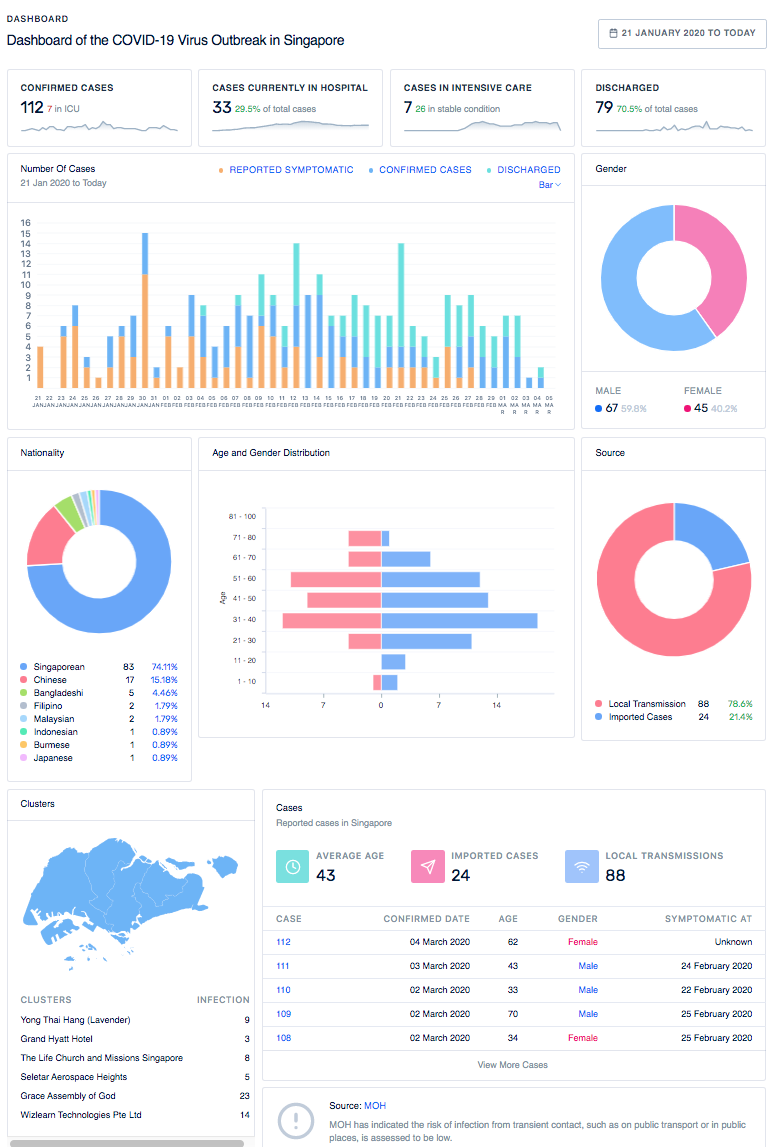
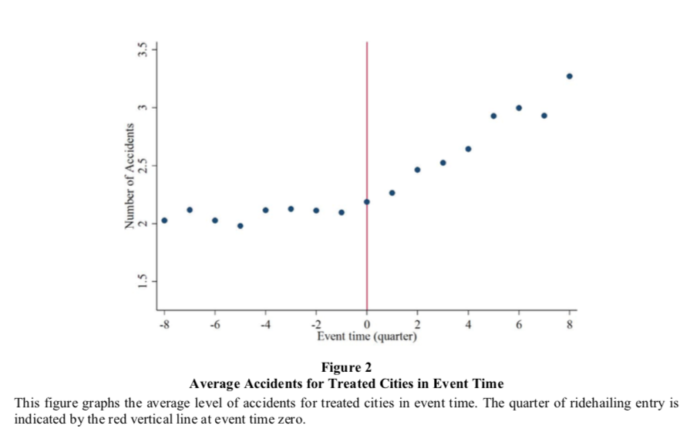

 Shayanne Gal/Business Insider
Shayanne Gal/Business Insider
